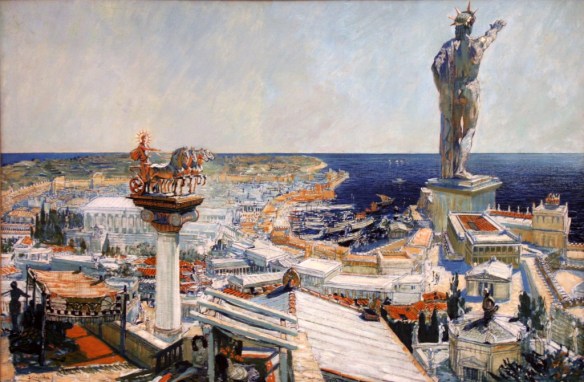
Plan of the shipsheds of the military port of Rhodes: those to the west are the width suitable for larger triremes and quadriremes, but the eastern slips are narrower and presumably intended for lighter craft like tribemioliae with which Rhodes was closely associated.
The ships rated higher than ‘ten’ seem not to have been used for ship-to-ship combat, so an additional explanation must be sought for their design. The use of ships as fighting platforms to attack city and harbour defences, for example by Demetrius I Poliorcetes against Rhodes in 305 (Diod. Sic. 20.85–8), suggests that the very large polyremes may have been designed with this function in mind. Demetrius’ fleet of 500 ships was likely to have been deployed against the coastal cities of Asia Minor, had he not been ousted from Macedon by Pyrrhus in 287. In this respect, the largest polyremes are analogous to the very large siege towers built for Demetrius’ attacks on Salamis and Rhodes in 306 and 305 respectively.
By no means all the ships used in the naval warfare of this period were triremes or polyremes. The Rhodian navy contained a substantial number of vessels of a type known as tribemioliae, which means something like ‘three and a half’. This ship was probably a variation of the trireme, or ‘three’. The Rhodian tribemioliae seem to have had a crew of 144, as compared to an Athenian trireme which had 200. It seems that about 120 of the crew were oarsmen, compared to the 170 used on the trireme. It is most likely that the reduction was effected by having fewer men on the lowest level, enabling the ships to be narrower towards the bows and stern than a trireme, thus compensating for the loss of oar power with a sleeker shape. As they also carried fewer marines and sailors, they would have been significantly cheaper to operate.
The various Macedonian generals who fought over all or part of Alexander’s empire were gifted with vast ambitions, enormous funds and manpower resources, plus access to the timber supplies of Cilicia, Syria, Phoenicia, Cyprus and Macedonia. Hence they were able to build substantial fleets of increasingly large ships. Antigonus Monophthalmus established three shipbuilding yards in Phoenicia, one in Cilicia and another on Rhodes to create the ships for his contest with Ptolemy I Soter. These facilities produced an impressive number of ships in the period 314–302, so many that Antigonus had nearly 400 warships, plus at least 100 transports.
Smaller political entities like the Achaean and the Aetolian Leagues, or the island of Rhodes, did not attempt to operate large fleets. In 191–190 the Rhodians played a significant part in the naval conflict between Rome and her allies and Antiochus III, but the largest Rhodian fleet assembled consisted of only thirty-two ‘fours’ and four triremes (Livy 37.22–3). The Rhodians had a good supply of experienced sailors, marines and naval officers, as well as well-trained oarsmen. It is likely that naval service was required of all young men with full or partial Rhodian citizenship, but even these reserves had to be supplemented by foreign oarsmen and sailors.